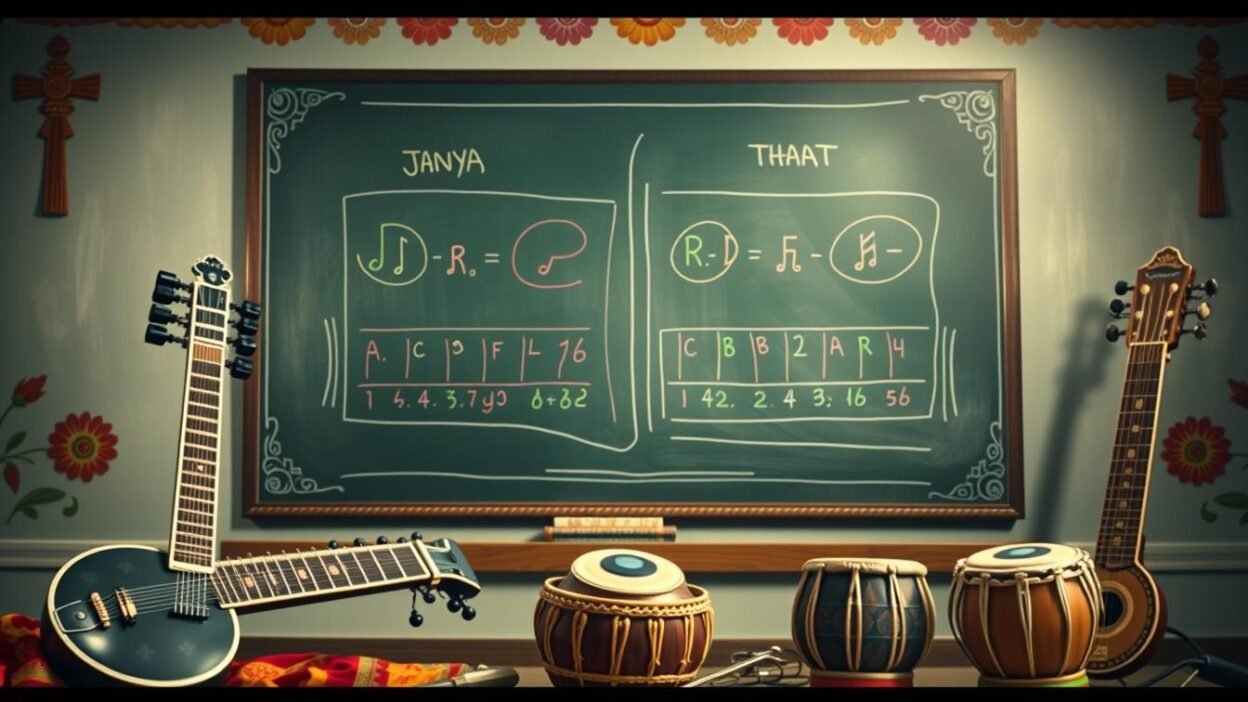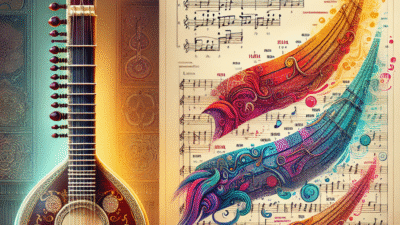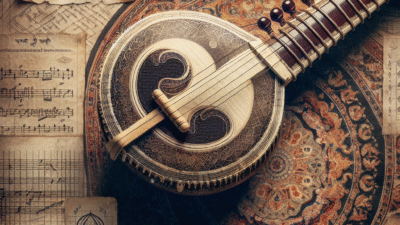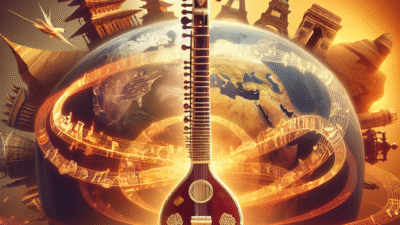Indian classical music is filled with ragas, including janya and thaat ragas. These are key parts of the UGC NET music syllabus. They help us understand Indian classical music theory.
For beginners, learning about janya and thaat ragas can be tough. But, it’s vital for those wanting to do well in the music theory exam. Studying these ragas deepens our grasp of music theory. It also shows us the rich details of Indian classical music.
Key Takeaways
- Understanding the basics of janya and thaat ragas is key for UGC NET music hopefuls.
- The way these ragas are grouped is a big part of the music theory syllabus.
- Getting these concepts can make us better at understanding Indian classical music.
- Studying janya and thaat ragas is important for doing well in the music theory exam.
- Knowing these ragas well can really improve our music theory skills.
Understanding Indian Classical Music: An Overview
Indian classical music is vast, with many ragas and thaats. It’s a key part of Indian culture, loved by people all over the world. Its deep emotions and complex structures are truly captivating.
What Is Indian Classical Music?
Indian classical music comes from the Indian subcontinent. It uses ragas and thaats as its foundation. Pt. Ravi Shankar said it’s a journey, not a destination, with each note and raga revealing something new.
This music has two main types: Hindustani from North India and Carnatic from South India. Both share a common heritage but differ in their ragas and performance styles.
Importance of Raagas and Thaats
Raagas and thaats are the heart of Indian classical music. A raga is a melodic framework with specific notes and emotions. Thaats categorize ragas by their notes.
Raagas and thaats evoke deep emotions, connecting musicians, audiences, and the music. Musicologist Nathan Hesselink says they allow for nuanced emotional expression, making the music deeply personal.
Structure of Indian Classical Music
Indian classical music’s structure is based on specific ragas and thaats. It emphasizes improvisation and creativity. A performance might include an alap, bandish, and taan.
It also uses laya and tala, adding complexity. Musicians must balance these elements while keeping the raga’s emotional and aesthetic integrity.
“The beauty of Indian classical music lies in its ability to balance structure and improvisation, creating a unique experience with each performance.”
Introduction to Raagas
Raagas are key to Indian classical music, representing musical scales and emotions. They are melodic modes with specific scales and emotional content.
Definition of Raagas
A raaga has a unique note sequence, setting it apart from others. It’s more than a scale; it’s a complex entity with rules for ascending and descending. It also has special notes for ornaments.
The structure of a raaga aims to evoke a certain mood or emotion. For example, Yaman raaga is calming, often played in the evening. Its note sequence and performance create a unique emotional experience.
The Role of Emotion in Raagas
Emotion is vital in playing raagas. Each raaga is linked to specific emotions, times, or seasons. Musicians aim to convey these emotions through their performance.
They use techniques like gamaks and meends to express a range of feelings. From joy to sadness, a skilled musician can evoke different emotions by adjusting pitch, tone, and rhythm.
Difference Between Raagas and Thaats
Raagas and thaats are both important in Indian classical music but differ in purpose. A thaat is a scale framework, while a raaga is a complex entity with scale, melody, and emotion.
Knowing the difference between raagas and thaats helps us appreciate Indian classical music’s depth. Thaats offer the scales, but raagas add the emotional and melodic richness.
Exploring Thaat: The Parent Scale
Understanding Thaat is key to grasping Hindustani music’s complexity. It’s the base for creating ragas. Musicians and music lovers need to know Thaat’s details to fully enjoy Hindustani music’s richness.
Definition and Characteristics of Thaat
A Thaat is a set of notes that shapes ragas. Thaats are the parent scales for many ragas. Each Thaat has its own set of notes and intervals, making each raga unique.
Thaats vary in the number of notes and how they’re arranged. Some Thaats have notes others don’t. This variety allows for a wide range of ragas, each with its own feel and mood.
“The concept of Thaat is fundamental to understanding the structure and diversity of ragas in Hindustani music.” –
Importance of Thaat in Music Composition
Thaat’s role in Hindustani music is huge. It’s the foundation for raga creation. Musicians use Thaats to improvise and compose, creating music that evokes emotions.
Thaats also help organize and classify ragas. By grouping ragas by Thaat, musicians and scholars can see how different ragas relate. This understanding deepens our appreciation of Hindustani music’s complexity.
| Thaat | Characteristics | Raga Examples |
|---|---|---|
| Bilaval | Known for its bright and uplifting quality | Deshkar, Shuddha Kalyan |
| Kafi | Characterized by its soothing and calming nature | Bhimpalasi, Piloo |
| Marwa | Recognized for its intense and evocative expression | Marwa, Purvi |
What are Janya Raagas?
Janya Ragas are a key part of Carnatic music. They come from the melodic patterns of thaats or melas. These ragas are not alone but are based on parent scales, showing the deep complexity of Carnatic music.
Definition of Janya Raagas
Janya Raagas are ragas that come from basic melas or thaats. The word “Janya” means “born of” or “derived from.” This shows these ragas are made from the basic sounds. In Carnatic music, Janya Raagas are very important for their emotional and beauty.
These derived ragas are not just simple changes. They are unique melodies that keep the essence of their parent scale. They offer new musical expressions. To make Janya Raagas, musicians change the parent scale in certain ways, like leaving out notes or changing their order.
How Janya Raagas Emerge from Thaats
The creation of Janya Raagas from thaats or melas follows a set process in Carnatic music. A thaat or mela is the starting point, with its foundational notes. Musicians and composers then use specific rules to create new Janya Raagas from these notes.
For example, a Janya Raga might be made by removing some notes from the parent scale or rearranging them. This not only makes a new raga but also gives it the emotional and aesthetic qualities of the parent thaat. The rules for creating and playing Janya Raagas are outlined in the ragam-thanam-pallavi framework.
Knowing how Janya Raagas come from thaats helps us understand the depth and richness of Carnatic music. It shows the creativity and innovation in this tradition. Musicians keep finding new melodies within the established patterns.
Classification of Janya Raagas
Understanding Janya Raagas involves knowing their structure, emotional feel, and where they come from. This knowledge is key for music exams and grasping music theory.
Structural Classification
Janya Raagas are sorted by how many swaras they have and the order of these swaras. This helps us see how each Raaga is unique and complex.
- Audava: Raagas with five swaras.
- Shadava: Raagas with six swaras.
- Sampoorna: Raagas with seven swaras.
Emotional Classification
The emotions tied to Janya Raagas are very important. Each Raaga brings out different feelings in listeners.
For example, Yaman is calm and peaceful. Other Raagas might make you feel happy or sad.
Regional Classification
Janya Raagas also tie to certain areas in India. This shows the variety and beauty of Indian classical music.
| Region | Common Janya Raagas |
|---|---|
| North Indian Classical Music | Yaman, Bhimpalasi |
| South Indian Classical Music | Kalyani, Shankarabharanam |
Knowing these classifications is vital for musicians in music theory exams. It also helps us enjoy Indian classical music more.
Key Janya Raagas in Indian Music
Janya Raagas are key in Indian classical music, bringing a wide range of melodies. They come from different thaats, adding depth and emotion to music. We’ll look at important Janya Raagas from Bilaval and Kafi thaats, showing their role in Indian classical music.
Popular Janya Raagas from Bilaval Thaat
Bilaval Thaat is a major thaat in Indian classical music. It has given birth to many significant Janya Raagas. Here are a few:
- Raag Deshkaar: Known for its soulful and evocative rendition, often used in vocal performances.
- Raag Shankara: Characterized by its distinctive scale and melodic patterns, often performed during late evening.
These Janya Raagas from Bilaval Thaat are rich in melody and evoke emotions. They are key in many musical pieces.
Popular Janya Raagas from Kafi Thaat
Kafi Thaat is also a significant thaat, known for its Janya Raagas. These are widely loved in Indian classical music. Here are a few examples:
- Raag Bhimpalasi: Known for its soothing and calming effect, often performed during the late afternoon.
- Raag Piloo: Characterized by its folk-inspired flavor, adding a unique dimension to classical music performances.
These raagas from Kafi Thaat add to the diversity and richness of Indian classical music. They offer a variety of emotional expressions and melodic nuances.
Characteristics of Major Janya Raagas
Indian classical music is filled with janya raagas. Yaman, Bhimpalasi, and Marwa are special because of their unique musical scales and deep emotions. These raagas have greatly influenced Indian music, adding depth and complexity.
Detailed Features of Yaman
Yaman raaga has a calming effect on listeners. It’s often played in the evening, bringing peace and tranquility.
- Scale: It uses the Kalyan thaat, focusing on komal (flat) notes.
- Emotional Content: It expresses deep emotions, like longing.
- Usage: Yaman is a favorite in concerts for its rich melody.
Detailed Features of Bhimpalasi
Bhimpalasi raaga has a unique sound. It combines shuddha (natural) and komal (flat) notes.
- Scale: It comes from the Kafi thaat, with natural and flat notes.
- Emotional Content: It’s romantic and emotive, often about love and longing.
- Usage: Bhimpalasi is loved in both classical and light music for its expressiveness.
Detailed Features of Marwa
Marwa raaga is ancient and revered. It has a solemn and meditative quality.
- Scale: It’s based on the Marwa thaat, focusing on shuddha (natural) and tivra (sharp) notes.
- Emotional Content: It’s about reverence, often used in spiritual themes.
- Usage: Marwa is played in the early morning, for its calm and contemplative feel.
These janya raagas enrich Indian music and show the emotional and cultural depth of the region. Yaman, Bhimpalasi, and Marwa continue to enchant listeners and inspire musicians with their unique qualities.
Popularity of Janya Raagas in Performance
Janya raagas are key in traditional concerts and modern music and films. Their appeal and creative use show their lasting value. Musicians across genres find them versatile and inspiring.
Use in Classical Concerts
In classical concerts, janya raagas are celebrated for their emotional and aesthetic qualities. Artists dive deep into the raaga’s structure, highlighting its unique traits and emotional depth. Raagas like Yaman and Bhimpalasi are favorites for their rich melodies and emotional impact.
Understanding the thaat of these raagas is essential. It lets artists improvise and create complex patterns. These patterns are both technically stunning and emotionally moving.
Adaptation for Fusion Music
Fusion music marks a new chapter for janya raagas. By mixing them with jazz, rock, or electronic music, artists create a unique sound. This appeals to a wider audience and offers a fresh take on traditional Indian music.
For example, jazz improvisations with janya raagas result in captivating pieces. These pieces keep traditional Indian music alive and exciting.
Influence in Film Music
Janya raagas have shaped film music in India. Film composers use their rich melodies to craft memorable songs. This adds depth and complexity to the music, enriching the film experience.
The raaga Marwa is often used to evoke longing or nostalgia. Its unique sound and emotional resonance make it a favorite for composers aiming to create a specific mood.
In summary, janya raagas’ popularity across different genres highlights their versatility. They play a vital role in Indian music, from traditional concerts to modern and film music.
Understanding the Concept of Raagini
In Indian classical music, Raagini is key in showing the emotional side of Raagas, like Janya Raagas. It’s a concept that looks into the emotional and artistic sides of music. It helps us see how different Raagas can stir up different feelings.
Relation Between Raagini and Janya Raagas
Raagini is closely tied to Janya Raagas. It explores the emotional sides of these Raagas. Janya Raagas, coming from main Thaats, get more depth with Raagini. This adds an emotional layer to their sound.
In Carnatic music, Raagini makes Janya Raagas more emotional and engaging. It’s like adding colors to a black and white picture.
Emotional Expression Through Raagini
Raagini is a strong way to express feelings in Indian classical music. Musicians use it to show a wide range of emotions. From calm to passionate, Raagini helps musicians connect with their audience.
For music examination preparation, knowing Raagini is key. It helps musicians express emotions better. It also makes their music more interesting and meaningful.
To get a better idea of Raagini, consider these points:
- The emotional depth of different Raagas and their connection to certain times or feelings.
- How Raagini makes Janya Raagas more beautiful.
- Using Raagini in various musical settings, like classical concerts and fusion music.
By looking into these points, musicians and music lovers can understand Raagini better. It’s important in Indian classical music, and more so with Janya Raagas.
Theoretical Framework of Indian Raagas
Indian Raagas, including Janya Raagas, are based on a deep theoretical framework. This framework includes complex notation systems and understanding scale degrees. It’s key for studying and practicing Indian classical music.
Notation and Documentation
The notation for Indian Raagas has changed over centuries. Different methods have been used to document Raagas. Good notation is key for keeping and sharing Indian classical music.
Traditionally, Indian music notation was simpler than Western notation. But, modern changes have made it more detailed. This helps learners grasp and practice Raagas better. As Pandit Ravi Shankar said, “Notation helps preserve music, but a musician’s soul brings it to life.”
Scale Degrees in Janya Raagas
Janya Raagas come from parent Thaats and have their own scale degrees. Knowing these scale degrees is essential for mastering Janya Raagas. These scale degrees shape the Raaga’s mood and when it’s best to play it.
- The choice of scale degrees affects the Raaga’s mood and emotional impact.
- Different Janya Raagas may use the same Thaat but have different scale degrees. This makes each Raaga unique.
- Learning Janya Raagas means understanding these scale degrees and how to use them in music.
By understanding the theory behind Indian Raagas, musicians and fans can better appreciate and master Indian classical music.
Challenges Faced by Beginners in Learning
Learning Indian classical music is tough for beginners. They must understand ragas and thaats, which are complex. These elements can be hard to grasp, leading to common mistakes and a long learning path.
Common Misunderstandings
Many beginners think ragas are just scales or melodies. But, ragas have deep emotional and cultural meanings. For example, the raga Yaman is linked with longing and played in the evening.
Some also think thaats are strict rules for ragas. But, thaats are basic scales that let artists be creative and improvise.
| Common Misunderstandings | Correct Understanding |
|---|---|
| Ragas are just musical scales. | Ragas are complex musical entities with emotional and cultural significance. |
| Thaats are rigid structures. | Thaats are foundational scales that allow for creativity and variation. |
The Role of Practice in Mastery
Practice is key to mastering ragas and thaats. Regular practice helps grasp their subtleties and develop necessary skills. It’s not just about repeating notes but also feeling the emotional depth of each raga.
Beginners should practice with a skilled guru or mentor. They can guide on how to play ragas and thaats right. Also, listening to experienced artists can deepen your understanding and love for these musical forms.
- Regular practice to internalize ragas and thaats.
- Guidance from a qualified guru or mentor.
- Listening to experienced artists.
Tips for Mastering Janya and Thaat Raagas
Mastering Janya and Thaat Ragas requires listening skills, practice, and a deep understanding of their theory. It’s important to mix theory with practice. This way, you can truly grasp the complexity of these ragas.
Listening Techniques for Beginners
Listening is key to mastering Janya and Thaat Ragas. Start by listening to recordings of skilled musicians in Hindustani and Carnatic music. Focus on the gamakas, emotional expression, and improvisation.
- Start with listening to ragas in different Thaats to understand their distinct characteristics.
- Pay attention to the Janya Ragas derived from these Thaats and note their unique features.
- Repeat listening to the same raga multiple times to grasp its subtleties.
Practical Exercises for Familiarity
Practical exercises are essential for getting familiar with Janya and Thaat Ragas. Singing or playing these ragas on instruments like the sitar or violin helps internalize their structures and nuances.
- Begin with simple exercises like practicing the arohan and avarohan of Janya Ragas.
- Gradually move on to more complex compositions and improvisations.
- Record yourself and listen back to identify areas for improvement.
Comparing different Janya Ragas within the same Thaat can reveal their unique traits. The table below shows a comparison of some popular Janya Ragas.
| Raga | Thaat | Characteristics |
|---|---|---|
| Yaman | Kalyan | Known for its soothing and calming effect, often performed at night. |
| Bhimpalasi | Kafi | Characterized by its use of komal ni and a distinct, emotive quality. |
| Marwa | Marwa | Noted for its intense, devotional expression and the use of shuddh re. |
By combining listening techniques with practice, learners can improve their mastery of Janya and Thaat Ragas. As you progress, the complexity of the ragas and your understanding will grow.
Resources for Further Learning
If you’re interested in Janya and Thaat Ragas, there’s a lot to explore. Resources are available for both beginners and those who already know a lot. They help you understand Indian Classical Music better.
Recommended Books and Literature
There are many books and texts that are great for learning more about Janya and Thaat Ragas. Here are a few:
- “Raga Guide: A Guide to the Ragas of Indian Music” – This guide explains different Ragas, their traits, and how they make us feel.
- “Indian Music: History, Tradition, and Forms” – This book goes deep into Indian Classical Music’s history and evolution. It talks about Janya and Thaat Ragas’ roles.
- “The Raga Quagmire: A Study in the Theory and Practice of Indian Music” – This study focuses on Ragas’ theory and how they’re used in music.
These books are perfect for those taking music exams or just wanting to learn more about musicology.
Online Courses and Workshops
Online learning is also a great way to explore Janya and Thaat Ragas. Here are some good options:
- Online Courses on Indian Classical Music – Sites like Coursera, Udemy, and edX have courses. They cover the basics and more, with videos and interactive parts.
- Workshops and Masterclasses – Music schools and artists offer workshops and masterclasses. They’re in-person or online, giving you direct experience and personal help.
These resources are great for those who like learning by doing or need help with music exams.
Conclusion: The Journey of Music Exploration
In Indian classical music, learning about janya and thaat ragas is a lifelong journey. It makes us understand culture and art better. These musical elements are deeply connected to India’s culture.
Connecting with Culture Through Music
Indian classical music is more than entertainment. It connects us to India’s rich cultural heritage. Ragas, with their complex structures and emotional depth, show the soul of Indian culture.
The emotional expression in these ragas lets listeners feel a range of emotions. From joy to longing, this music touches our hearts. It’s a key part of India’s cultural identity.
The Lifelong Learning of Raagas and Thaats
Mastering janya and thaat ragas is a long and challenging journey. But the rewards are great. They offer insights into Indian classical music and its cultural importance.
Comparing different ragas helps deepen our understanding. Here’s a table showing some major janya ragas:
| Raga | Thaat | Emotional Expression |
|---|---|---|
| Yaman | Kalyan | Peace, Serenity |
| Bhimpalasi | Kafi | Longing, Romance |
| Marwa | Marwa | Gravity, Seriousness |
Reflecting on janya and thaat ragas in Indian classical music shows their importance. Their study is a lifelong journey. It enriches our music understanding and connects us to India’s cultural heritage. With continued learning, this rich musical tradition will thrive.
FAQ Section on Janya and Thaat Raagas
Understanding janya and thaat ragas is key for music lovers and students. These ragas are the heart of Indian classical music. Knowing their details is vital for grasping musicology.
Common Forms of Janya Raagas
Janya ragas come from thaat ragas and are key in Indian classical music. The Bilaval and Kafi thaats are famous for their unique emotional sounds.
Influence of Thaats on Janya Raagas
Thaats shape janya ragas by giving them their base scale. The thaat’s traits decide the mood and structure of its janya ragas. This makes thaats essential in music making.
Application in Modern Music Genres
Janya ragas are not just for traditional music; they’re also in modern styles like fusion and film scores. They bring cultural depth and appeal to more people.
FAQ
What is the difference between a raga and a thaat in Indian classical music?
A thaat is a basic scale in Indian classical music. It has a specific sequence of notes. On the other hand, a raga is a melodic mode. It comes from a thaat and has its own unique feel, emotions, and rules for improvisation.
How are janya ragas derived from thaats or melas in Carnatic music?
Janya ragas come from thaats or melas by applying certain rules. This creates a new raga with its own special traits and emotional feel.
What are some common janya ragas in Indian music, and how are they used in different musical contexts?
Common janya ragas include Yaman, Bhimpalasi, and Marwa. They are used in concerts, fusion music, and films. They help create different moods and emotions.
How do thaats influence the creation and characteristics of janya ragas?
Thaats are the base for janya ragas. They provide the notes and framework for the janya raga. This affects its sound, emotions, and overall feel.
Can janya ragas be used in modern music genres, and how are they adapted?
Yes, janya ragas can be used in modern music. They are adapted by changing their melody, emotions, and improvisation rules. This makes them fit different musical styles.
What is the significance of raagini in Indian music, and how is it related to janya ragas?
Raagini is about the emotional and aesthetic appeal of a raga. It’s closely tied to janya ragas. The emotions and traits of a janya raga are often shown through its raagini.
What are some common challenges faced by beginners in learning Indian classical music, and how can they be overcome?
Beginners struggle with the music’s complex theory, mastering raga and thaat, and improving improvisation. These challenges can be beaten with practice, listening to experts, and getting help from teachers.
What resources are available for further learning and exploration of janya and thaat ragas?
For more learning, there are books, online courses, and workshops. You can also attend concerts and performances by skilled musicians.





